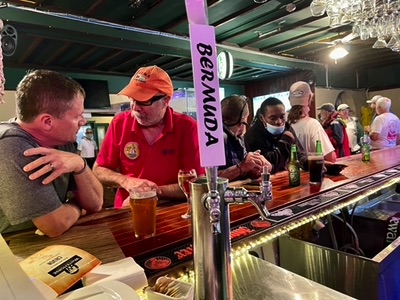After a rough crossing, Bermuda is welcoming stop.


Bermuda:
Stopping in on your way to the Caribbea
Story and Photos by David H. Lyman, for Cruising World
This appeared originally in the April 2024 edition of Caribbean Current, a monthly newsletter from Cruising World Magazin. It's been updated.
By early October I am typically making plans for another offshore voyage to the Caribbean, and that always means a stop in Bermuda. And, I’ll not be alone.
If you are leaving from most any port in New England, Bermuda is right on the way. If you are departing from the mouth of the Chesapeake, you should be passing within 50 to 100 miles of Bermuda. The reason I say 'should be’ is that you want to get as far east as possible before turning south, that take brings you pretty closer to Bermuda.
Why Stop in Bermuda?
Because it’s there. It’s right on the way south, and north.
After a 3 to 4 day sail, across the Gulf Stream, dealing with fall’s fickle weather systems, a tired crew, and broken gear, Bermuda is a welcomed pitstop. There’s always something that needs fixing, and Bermuda is rife with mechanics, sailmakers, and electronics and refrigeration technicians to lend a hand. You can get a sail repaired, take on fuel, stock up on groceries, and give the crew a few days’s break to explore this beautiful island. There’s also a hardware store, numerous restaurants, and a round of Dark and Stormies at the legendary White Horse Tavern, right by the docks. US currency and credit cards are accepted. English is spoken, as Bermuda is a British Overseas Territory. Bermuda is well worth a few days of sightseeing, as evidenced by tourists that have flocked there for generations. Most important, Bermuda is a great shakedown for boats and crew; and a great place to wait for favorable weather before starting out on the next leg of the voyage south.
Bermuda is also a good place to drop off and pick up new crew. Arriving crew need a letter from the yacht’s owner /skipper attesting to the fact the individual is joining the yacht (by name).
Getting There
Sailing to Bermuda is 640 nm from Newport, 620 nm from the mouth of the Chesapeake: a 4 to days sail. Sailing will be brisk in a strong northwesterly as you leave the mainland. Those departing from Newport will reach the north wall of the Gulf Stream within 36 hours; for those departing Cape Henry, they'll be through the Gulf Stream in 24 hours, and in warmer weather. Things may get dicy half away across as cold fronts sweep off the East Coast with frustrating frequency, but the winds are usually behind you, making for a fair run into Bermuda.
Before You Depart
Before you cast off for Bermuda, go online and download the Bermuda pre-arrival paperwork. There are three forms. Everybody is required to fill out a Landing Card. Every country has one. They’re available at gotobermuda.com/bermuda-arrival-card. You can fill out the card and submit it online. Bermuda acknowledge receit and provide a proof om your phone.
Next-
Skippers of private yachts planning to stop in Bermuda must complete the Bermuda Mariner’s Travel Authorization process online. This involves two forms to be submit it online. This can be found at
Click on the first form, and complete the SailClear form for Customs and Immigration. The second is The Pre-Arrival Safety form. This must be completed must be completed by the skipper before you enter Bermuda. You can fill it out and submit it online. If you don't, you'll be filling it out stranding in your navstation, talking to Bermuda Radio on VHF, while still 20 miles out at sea. Once you fill it out, they'll have it for your next stop in Bermuda.
Click on and read the information on the third link. You can skip the link dealing with Super Yachts.
Approachingh Bermuda
With your paperwork complete, you are now ready to approach Bermuda. The island is relatively flat, you’ll see a sweep of lights from the airport and lighthouses before you see land. The island is ringed with shallow reefs, so approach with caution. There’s only one way into the island, and that’s through Town Cut on the northeast corner of the island. You’ll be arriving in Saint George’s Harbor, where all yachts clear in.
When you are still 50 miles away from Bermuda, you may hear Bermuda Radio talking to other yachts on VHF 16. Bermuda Radio is the island’s maritime control center. Hail them when you are 20 miles out, or they will call you. They have you on AIS and radar, and they’ll want to know who you are and your intentions. (If you’ve completed your Yacht Safety Information online, they’ll have it. If you haven't, they will ask you to do so.) From there, they’ll direct you to enter Town Cut or wait for shipping to enter or exit. Once inside, they’ll either direct you to tie up at Ordnance Island to clear in, or to anchor in Power Hole, across from the village, and wait.
The entrance channel into St. George’s is well marked, but the day markers on the port side are unlit. At night, have someone with a flashlight on the port side to light up the reflectors. Town Cut itself is narrow, then opens up into a large, well-protected harbor. The village of St. George’s is ahead to starboard.
Clearing In
All yachts are required to tie up at Ordnance Island. There’s room for two boats at a time. The skipper takes passports and the ship’s papers to the office, in the gray, single story building, on the dock for processing. In my experience, the folks there are a friendly lot, and if your paperwork is in order and has been submitted online, the whole process takes less than 30 minutes. If you are a yacht just passing through, a 5-day transit permit is required at $5 per meter. Cruising permits, for longer stays, are $6.50 per meter. There are no other fees. (Salty Dawg Rally boats are exempt from these transit fees. Make sure you are on the list.)
While you’re there, request a transit fuel waiver form. This will authorize you to take on duty-free fuel.
Dockage and Anchoring
You can anchor most anywhere in the harbor with no charge. Holding is good, even in a blow. There’s a dinghy dock on the quay in the village, opposite the customs dock. Trash and spent engine oil receptacles are there as well.
For dockage along side, you’ll find a number of places to tie-up alongside in the village or at the St. George’s Dinghy & Sports Club.
Space in town is assigned by St. George’s Marina through its website. April, May, and June are on a first-come, first-served basis, but it is still a good idea for vessels to submit a request via the website.
Tying up in town puts you and your crew right in the middle of things. Stores, modern and clean bathrooms, banks, pubs, and the bus service. The St. George’s Dinghy & Sports Club is located at the east end of the harbor, to the right, just as you enter St. George’s Harbor. There’s stern-to space for two dozen yachts at their concrete pier. Water may be available, but not fuel. The clubhouse has a bar with a happy hour, pool tables and a dart board, laundry, showers, and bathrooms. It’s a fifteen-minute walk into the village.
Bermuda Yacht Services (BYS) is your friend in Bermuda. BYS will arrange anything you need, from repairs and sails to mechanical and rigging services. BYS is located in the St. George’s Yachtsmen’s Center on Ordnance Island. There’s free WiFi, bathrooms and showers, an inside lounge, and benches on the porch are available for use.
Refueling
There is fuel dock in town at RUBiS Dowling’s Marine Service Station, but it’s not duty-free, so it can be pretty expensive. There are two options for taking on duty-free fuel. If there are enough boats needing fuel, Mark Sores at BYS will arrange for a fuel truck to come down to the dockside. This gets done all at once, as one yacht after another comes alongside to top off. The price will be a couple of bucks cheaper per gallon than the non-duty free. (You’ll need that waiver you obtained at Customs.)
If you are cruising alone and need fuel, you can get it duty-free at the big fuel depot at the Dockyard, at the other end of the island. From St. George’s, this will require a half-day’s motoring down, then all the way back. It’s a pleasant trip, and we’ve done it numerous times.
Out and About
Bermuda’s name was given to the island by a Spanish captain, Juan de Bermúdez, who stumbled on the archipelago in 1505. The village of St. George’s was first settled in 1609, when an English ship, the Sea Venture, carrying colonists to Virginia, was swept onto Bermuda’s reefs during a storm. Shakespeare turned the event into his famous play, The Tempest. The crew and passengers managed to save much of their cargo, even enough lumber from the wrecked ship to build two, smaller ships, aboard which some colonists continued onward to Virginia. Two souls remained on the island.
The Virginia colony failed, but by 1612 a permanent settlement on Bermuda had been established. It’s the oldest English colony in the New World, eight years before Plymouth in Massachusetts. For a century or two, St. George’s served as Bermuda’s capital and its main port. During the American Revolutionary War, and the US Civil War, Bermuda’s “Forty Thieves,” the founding families, built their wealth on privateering, block-aid running, and supplying ammunition to both sides.
The oldest continually inhabited English settlement in the New World, St. George’s overflows with 17th and 18th century architecture, cobblestone alleys, and other signs of the past.
Even today, much of the village of St. George’s resembles an old village on the Cornish coast of England. Winding alleys of small, colorful cottages cover the hillside by the harbor, some dating back to the 1600s. There’s a very nice public restroom by the docks and a food store, Somers, a block away. They have most everything you’ll need for your next voyage, as well as a take-away buffet of hot and cold entries. A do-it-yourself laundromat is a short walk from the docks. A hardware store is on the main road, at the end of the commercial docks. The bus stops at the top of the hill. (Get your tickets at the adjacent convenience store.)
In the center of the village, you’ll find banks, a post office, a stationery and drug store, clothing shops, and a handful of restaurants. Take the ten-minute stroll up and over the hill to Tobacco Bay Beach on the north side of the island, where a great pink-sand beach and snack bar await. Then, continue onward around Saint Catherine’s Point and back to the village. It’s about an hour’s walk.
Because car rentals are not allowed in Bermuda, you might decide to get around by moped or scooter, but don’t! Delivery skippers have lost crew from moped accidents . David H. Lyman
Due in part to tourism but mostly to the island’s recent rise as an international insurance center, today, Bermuda is among the world’s wealthiest islands and, therefore, is expensive. Hamilton, the island’s current capitol, looks a bit like Miami, with an eclectic blend of gleaming high-rise office complexes, 1920s resort hotels, and quaint cottages. You can catch a ride into Hamilton on a very nice and efficient bus service from St. George’s. There are no car rentals, so taxis are the way to go.
Clearing Out
This is the easy part. No need to bring the boat alongside. Simply leave it on the dock or at anchor and proceed to Customs and Immigrations on foot. Then, it’s onward toward the Caribbean, US Mainland, or Europe and beyond.



St. Georges inner harbor-- Customs and immigrations is the gray building on the left. Yachts rafted up along the town's quay, clode the White Horse Tavern. The dinghy dock is at right in the foreground.









Customn and Immigrations in the gray building.
Open (and free) anchorage in Convist Bay.
Yachts rafting up in town.
Dowlings fuel dock in town
Yachts alongside the commerical docks for fuel.


There are two forms here, plus general a information form.


Bermuda sit out there in the Atlantic 600+ miles from the US Coast, 850 north of the Caeribbean.


The Bermuda Yacht Service Center, near to the Customns Office, has free WiFi, bathooms and showers.
Here's the link to the YouTube video.
https://www.youtube.com/watch?v=07tuhRJtWj0